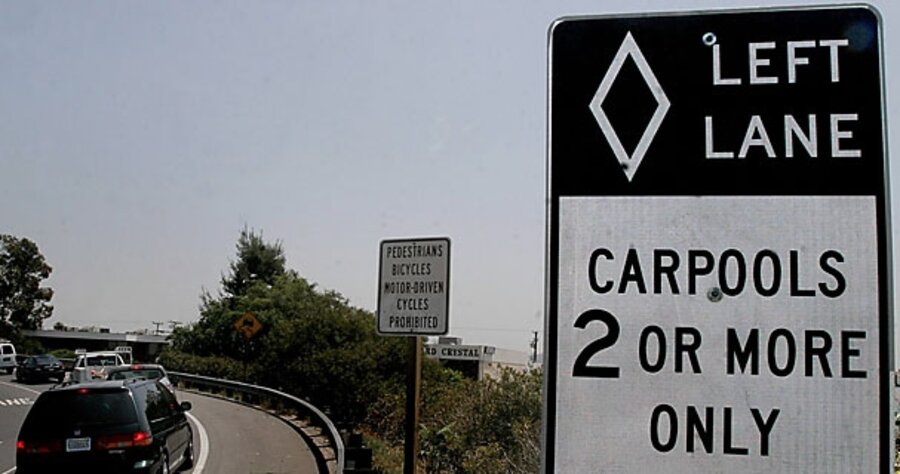How to hitch a ride on the Web
Loading...
James Tresner, a senior at Middlebury College in Vermont, used to ask around in his dorm or consult friends in hopes of finding someone to share expenses with when he drove home to Connecticut on break. Now he casts a wider net with just a few clicks of his mouse.
Mr. Tresner simply logs on to GoLoco.org, a social-networking website that connects carpoolers across the United States and Canada. For Tresner, a side benefit was a stimulating conversation with a fellow student from Tibet as the two shared Tresner’s car over a Thanksgiving break.
As gas prices climb and global-warming headlines blare, more people are looking for ways to save fuel, including carpooling. GoLoco is one of several websites that is helping to match rides and riders. The scope of potential poolers is big: A 2005 US Census Bureau survey, the latest available, found that only about 11 percent of workers carpool, while 77 percent drive to work alone.
Besides being environmentally sound (cars contribute 20 percent to the US carbon footprint) and potentially convivial, carpoolers save cash.
Robin Chase, the creator of GoLoco and the cofounder of Zipcar (a car-sharing business), notes that carpooling can “cut the cost of travel in half, if you share the price.” In 2002, the average US household spent $7,825 on transportation, according to the Department of Transportation. This year, AAA reported that the per-mile cost of operating a new vehicle rose to 54.1 cents per mile, up 1.9 cents in a year. Today it costs an average of $8,121 to operate and maintain a car every year, AAA figures show. GoLoco riders and drivers usually split travel expenses equally, based on a cost of 50 cents per mile traveled.
GoLoco, based in Cambridge, Mass., began in April 2007. On the site, people can post trips, listing starting locations and destinations – provided or desired. Users can create profiles with photos. They may list interests, musical preferences, and languages spoken. They can chat with one another without revealing phone numbers, and arrange to pay for tolls and gas expenses in advance (for a 10 percent transaction fee) through the website. Call it electronic hitchhiking – but you get to choose your travel companion ahead of time.
When Stephanie Groll’s car died two years ago, she and her husband chose not to buy another. Instead the Cambridge, Mass., couple decided to use public transportation to get to work and rent a Zipcar for weekend trips. Although they had used Craigslist’s ride-sharing community on a few trips, Groll was wary of not knowing anything in advance about the people with whom she’d be traveling. “We just could not screen them other than their e-mails,” Groll says. She turned to GoLoco. Her only quibble is that she wishes the site were more popular, so there would be more rides and riders listed. “As soon as there’s a critical mass on GoLoco,” she says, “it will be a powerful tool for people who don’t own cars or for people who do own cars.”
So far, the site lists 10,000 users, an increase over just the past few weeks – probably the result of rising gas prices. “I think in general, ride-sharing is going to become a very common and socially acceptable way to travel,” GoLoco founder Chase says. “We will look back on today and think, ‘What were we thinking, driving alone in these expensive cars, using this much fossil fuel?’ and how boring and expensive it was.”
Why haven’t carpools caught on more? Perhaps people aren’t ready to give up the freedom that goes with commuting alone. “There’s a bit of inconvenience,” says Steven Schoeffler, creator of Erideshare, a ride-sharing website based in Edwardsville, Ill. “You have to adapt your schedule to somebody else’s.” Erideshare boasts 25,000 to 35,000 active users worldwide. But he also stresses the potential benefits – networking advantages in employee carpools and making friends with people in your community.
Ride-sharing websites aren’t brand-new: A simple Web search for “carpool” or “ride sharing” returns a long list of options. But some ride-sharing websites jazz up the carpooling experience. NuRide.com, created in 2002, gives people reward points each time a person participates in a carpool. The points can be cashed in for gift certificates to restaurants, movies, and retail stores. Each time you travel with one other passenger you earn 100 points. The more passengers, the more points. (The service currently serves about 33,000 clients in parts of Virginia, Connecticut, Minnesota, and several big cities.)
Lisa Sattler-Biesak, senior executive for NuRide.com, notes that 6,000 new clients have signed up just since April. It’s “hard to get people to leave their cars at home every once in a while,” she says. “Once we were around $4 a gallon everything changed. People are now totally willing to change their driving behavior in order to save money.”
Travel-behavior analyst and author Alan Pisarski observes that these ride-sharing websites aren’t always indicative of carpooling trends. “They’re very anecdotal,” he says. “You don’t know really to what extent they’ve been formed [or] once they get formed [how long] they stay formed.”
There’s no doubt in his mind that carpooling has increased lately. It faded in the 1980s and ’90s, when fuel and vehicle ownership costs were lower and jobs were moving to suburbia, he says. Now he sees an increase in carpools among recent immigrants and families, forming what he calls “fampools”
“It’s really a trade-off between convenience and cost, and when the cost begins to rear its ugly head again, people begin to say, ‘Yes, it’s less convenient, but now that gas costs $4 a gallon I’m willing to ride with people.’”






